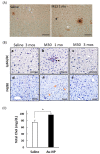Assessment of Polyethylene Glycol-Coated Gold Nanoparticle Toxicity and Inflammation In Vivo Using NF-κB Reporter Mice
- PMID: 33142808
- PMCID: PMC7662512
- DOI: 10.3390/ijms21218158
Assessment of Polyethylene Glycol-Coated Gold Nanoparticle Toxicity and Inflammation In Vivo Using NF-κB Reporter Mice
Abstract
Polyethylene glycol (PEG) coating of gold nanoparticles (AuNPs) improves AuNP distribution via blood circulation. The use of PEG-coated AuNPs was shown to result in acute injuries to the liver, kidney, and spleen, but long-term toxicity has not been well studied. In this study, we investigated reporter induction for up to 90 days in NF-κB transgenic reporter mice following intravenous injection of PEG-coated AuNPs. The results of different doses (1 and 4 μg AuNPs per gram of body weight), particle sizes (13 nm and 30 nm), and PEG surfaces (methoxyl- or carboxymethyl-PEG 5 kDa) were compared. The data showed up to 7-fold NF-κB reporter induction in mouse liver from 3 h to 7 d post PEG-AuNP injection compared to saline-injected control mice, and gradual reduction to a level similar to control by 90 days. Agglomerates of PEG-AuNPs were detected in liver Kupffer cells, but neither gross pathological abnormality in liver sections nor increased activity of liver enzymes were found at 90 days. Injection of PEG-AuNPs led to an increase in collagen in liver sections and elevated total serum cholesterol, although still within the normal range, suggesting that inflammation resulted in mild fibrosis and affected hepatic function. Administrating PEG-AuNPs inevitably results in nanoparticles entrapped in the liver; thus, further investigation is required to fully assess the long-term impacts by PEG-AuNPs on liver health.
Keywords: NF-κB; PEG surface modification; gold nanoparticle; liver inflammation; reporter imaging; steatosis.
Conflict of interest statement
The authors declare no conflict of interest. The funders had no role in the design of the study; in the collection, analyses, or interpretation of data; in the writing of the manuscript, or in the decision to publish the results.
Figures






Similar articles
-
A higher dose of PEGylated gold nanoparticles reduces the accelerated blood clearance phenomenon effect and induces spleen B lymphocytes in albino mice.Histochem Cell Biol. 2022 Jun;157(6):641-656. doi: 10.1007/s00418-022-02086-0. Epub 2022 Feb 14. Histochem Cell Biol. 2022. PMID: 35157114
-
Influence of anchoring ligands and particle size on the colloidal stability and in vivo biodistribution of polyethylene glycol-coated gold nanoparticles in tumor-xenografted mice.Biomaterials. 2009 Apr;30(10):1928-36. doi: 10.1016/j.biomaterials.2008.12.038. Epub 2009 Jan 7. Biomaterials. 2009. PMID: 19131103 Free PMC article.
-
Influence of PEG coating on the oral bioavailability of gold nanoparticles in rats.Drug Deliv. 2017 Nov;24(1):591-598. doi: 10.1080/10717544.2017.1282554. Drug Deliv. 2017. PMID: 28222611 Free PMC article.
-
Polyethylene glycol-gold nanoparticles.2008 May 26 [updated 2008 Jun 9]. In: Molecular Imaging and Contrast Agent Database (MICAD) [Internet]. Bethesda (MD): National Center for Biotechnology Information (US); 2004–2013. 2008 May 26 [updated 2008 Jun 9]. In: Molecular Imaging and Contrast Agent Database (MICAD) [Internet]. Bethesda (MD): National Center for Biotechnology Information (US); 2004–2013. PMID: 20641962 Free Books & Documents. Review.
-
Quantitation of PEG on PEGylated Gold Nanoparticles Using Reversed Phase High Performance Liquid Chromatography and Charged Aerosol Detection: Version 1.0.2017 Oct. In: National Cancer Institute’s Nanotechnology Characterization Laboratory Assay Cascade Protocols [Internet]. Bethesda (MD): National Cancer Institute (US); 2005 May 1–. NCL Method PCC-16. 2017 Oct. In: National Cancer Institute’s Nanotechnology Characterization Laboratory Assay Cascade Protocols [Internet]. Bethesda (MD): National Cancer Institute (US); 2005 May 1–. NCL Method PCC-16. PMID: 39012983 Free Books & Documents. Review.
Cited by
-
Intracellular Exposure Dose-Associated Susceptibility of Steatotic Hepatocytes to Metallic Nanoparticles.Int J Mol Sci. 2021 Nov 23;22(23):12643. doi: 10.3390/ijms222312643. Int J Mol Sci. 2021. PMID: 34884447 Free PMC article.
-
Prospects of Using Gum Arabic Silver Nanoparticles in Toothpaste to Prevent Dental Caries.Pharmaceutics. 2023 Mar 8;15(3):871. doi: 10.3390/pharmaceutics15030871. Pharmaceutics. 2023. PMID: 36986733 Free PMC article.
-
Exploring the Potential of Gold Nanoparticles in Proton Therapy: Mechanisms, Advances, and Clinical Horizons.Pharmaceutics. 2025 Jan 30;17(2):176. doi: 10.3390/pharmaceutics17020176. Pharmaceutics. 2025. PMID: 40006543 Free PMC article. Review.
-
Recent Advances in Photothermal Therapies Against Cancer and the Role of Membrane Transporter Modulators on the Efficacy of This Approach.Technol Cancer Res Treat. 2023 Jan-Dec;22:15330338231168016. doi: 10.1177/15330338231168016. Technol Cancer Res Treat. 2023. PMID: 37138532 Free PMC article. Review.
-
Preclinical Toxicological Characterization of Porphyrin-Doped Conjugated Polymer Nanoparticles for Photodynamic Therapy.Pharmaceutics. 2025 May 1;17(5):593. doi: 10.3390/pharmaceutics17050593. Pharmaceutics. 2025. PMID: 40430884 Free PMC article.
References
-
- Lee K.Y., Lee G.Y., Lane L.A., Li B., Wang J., Lu Q., Wang Y., Nie S. Functionalized, long-circulating, and ultrasmall gold nanocarriers for overcoming the barriers of low nanoparticle delivery efficiency and poor tumor penetration. Bioconjug. Chem. 2017;28:244–252. doi: 10.1021/acs.bioconjchem.6b00224. - DOI - PubMed
MeSH terms
Substances
Grants and funding
LinkOut - more resources
Full Text Sources

